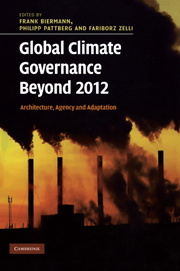Book contents
- Frontmatter
- Contents
- List of contributors
- Preface
- List of abbreviations
- 1 Global climate governance beyond 2012
- Part I Architecture
- 2 The architecture of global climate governance
- 3 The consequences of a fragmented climate governance architecture
- 4 Environmental effectiveness and economic consequences of fragmented versus universal regimes
- 5 Developing the international carbon market beyond 2012
- 6 The overlap between the UN climate regime and the World Trade Organization
- 7 An architecture for long-term climate change
- 8 Shaping the architecture of future climate governance
- Part II Agency
- Part III Adaptation
- Index
- References
6 - The overlap between the UN climate regime and the World Trade Organization
lessons for climate governance beyond 2012
Published online by Cambridge University Press: 05 July 2014
- Frontmatter
- Contents
- List of contributors
- Preface
- List of abbreviations
- 1 Global climate governance beyond 2012
- Part I Architecture
- 2 The architecture of global climate governance
- 3 The consequences of a fragmented climate governance architecture
- 4 Environmental effectiveness and economic consequences of fragmented versus universal regimes
- 5 Developing the international carbon market beyond 2012
- 6 The overlap between the UN climate regime and the World Trade Organization
- 7 An architecture for long-term climate change
- 8 Shaping the architecture of future climate governance
- Part II Agency
- Part III Adaptation
- Index
- References
Summary
Introduction
In Chapter 2, Biermann et al. discuss the increasing fragmentation of international climate governance. In this chapter, we focus on one element of this fragmentation, namely the overlap between the UN climate regime and the World Trade Organization (WTO). With a view to the appraisal question for the ‘architecture’ theme of this volume, we hold that this overlap not only implies benefits, but may also entail significant drawbacks for the development and implementation of the UN climate regime. This raises the question how this overlap can be addressed beyond 2012. Our main argument is that, when developing future strategies for managing this interlinkage, policy-makers should draw lessons from the past, that is, from the potential negative effects of this overlap, and from shortcomings of previous management approaches.
In Section 6.2, we introduce our methodology. Section 6.3 introduces major issues on which the two regimes overlap and respective management approaches, which have hardly yielded significant results. In Section 6.4, we discuss policy options that may be suitable to address these unresolved issues and debates in the future. We argue that appropriate strategies need to take into account core reasons for the observed interlinkages and for previous management failures: the constellation of strategic interests and the partial lack of consensual knowledge on climate–trade overlaps. We therefore suggest bringing in further expertise on climate–trade interlinkages – for example through a separate chapter in the next assessment report of the Intergovernmental Panel on Climate Change (IPCC) – as well as strategic issue-linking, for example regarding negotiations on biofuels and the transfer of climate-friendly technologies.
- Type
- Chapter
- Information
- Global Climate Governance Beyond 2012Architecture, Agency and Adaptation, pp. 79 - 96Publisher: Cambridge University PressPrint publication year: 2010
References
- 10
- Cited by



